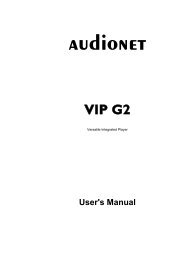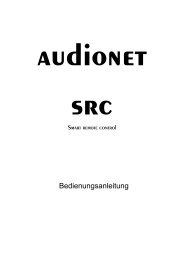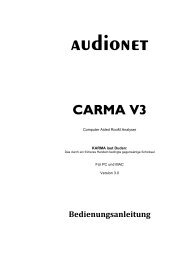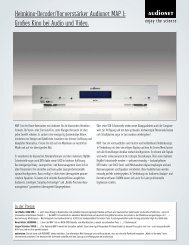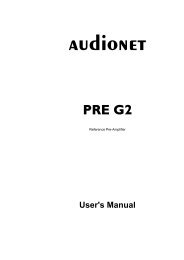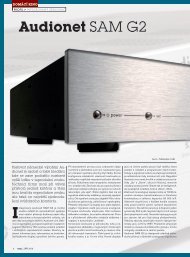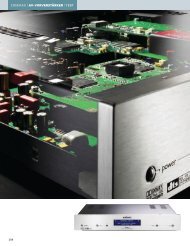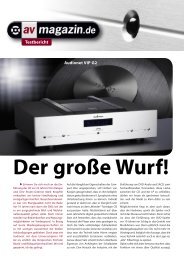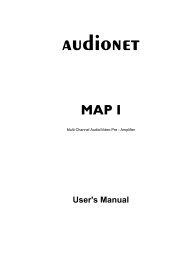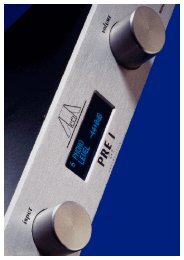Create successful ePaper yourself
Turn your PDF publications into a flip-book with our unique Google optimized e-Paper software.
The first line shows information about the current decoder mode:<br />
Display Decoder mode<br />
Test Tone on Test tone generator is active<br />
Stereo PCM input signals<br />
PCM 2-Ch Stereo 2-channel PCM is played back as stereo signal<br />
A/D conv 2ch Analog-to-Digital-converted stereo signal<br />
Dolby PLIIx Movie Dolby Pro Logic IIx in Movie mode<br />
Dolby PLIIx Music Dolby Pro Logic IIx in Music mode<br />
Dolby PLIIx Matrx Dolby Pro Logic IIx in Matrix mode<br />
Dolby Pro Logic Dolby Pro Logic IIx in Pro Logic mode<br />
DTS Neo:6 Cinema DTS Neo:6 in Cinema mode<br />
DTS Neo:6 Music DTS Neo:6 in Music mode<br />
Bitstream input signals<br />
Dolby Digital Dolby Digital<br />
Dolby Digital EX Dolby Digital EX<br />
Dolby D+PLIIx Mov Dolby Digital with Pro Logic IIx in Movie mode<br />
Dolby D+PLIIx Mus Dolby Digital with Pro Logic IIx in Music mode<br />
Dolby D+PLIIx Mtx Dolby Digital with Pro Logic IIx in Matrix mode<br />
Dolby Digital + PL Dolby Digital with Pro Logic IIx in Pro Logic mode<br />
Dolby D 2-ch St Dolby Digital played back as 2-channel stereo signal<br />
D T S DTS Digital Surround<br />
DTS-ES Discrete DTS-ES Discrete<br />
DTS-ES Matrix DTS-ES Matrix<br />
DTS+Neo:6 Cinema DTS with Neo:6 in Cinema mode<br />
DTS+Neo:6 Music DTS with Neo:6 in Music mode<br />
DTS 96/24 DTS 96/24<br />
DTS 96/24 + D8 DTS 96/24 with <strong>Audionet</strong> D8<br />
DTS 2-ch Stereo DTS played back as 2-channel stereo signal<br />
<strong>Audionet</strong> HighBit<br />
Input signals via <strong>Audionet</strong> HighBit interface<br />
MAP V2 receives audio data via the <strong>Audionet</strong> HighBit interface<br />
from an <strong>Audionet</strong> source (e.g. VIP G2 or ART G2)<br />
On the left of the second line the program format of the input signal is displayed by<br />
m/n.x, with m = number of front channels, n = number of surround channels and x =<br />
1, if LFE channel (Low Effects Frequency channel) available or x = 0, if LFE is not<br />
available in the program material.<br />
While receiving digital input signals, the current sample rate (in kHz) is shown in the<br />
middle of the second line.<br />
If the input signal is a bitstream (like Dolby Digital or DTS), the current bitrate is<br />
displayed as kbps (kbit per second) in the lower right corner of the display. In case of a<br />
39



